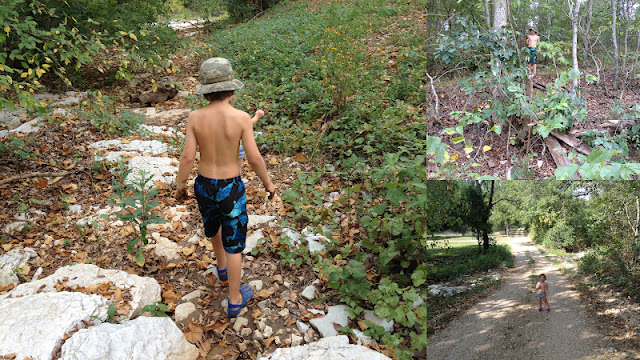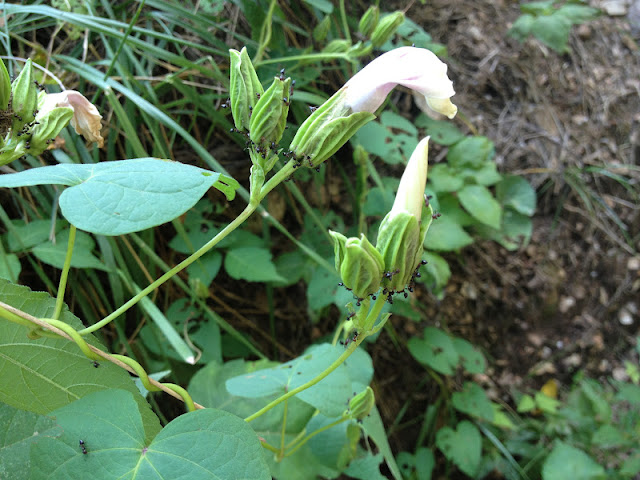One of the most important things in the kids' life now are the chickens. Jaden especially loves chickens, and Liv loves holding them, too. We're waiting to see any day now whether some eggs Jade has in his incubator hatch. Our friends Paul and Lisa gave him an incubator that they were given and didn't want, so he didn't have to build or buy one. The only problem is that there is no thermometer on there, so I'm really not sure whether he will have success with this first batch. And the eggs he got? Well, one of our chickens was already laying on them for a few days before he took (stole) them.
I was lying down with the baby and Liv one day last week and did not realize that Jaden was taking a shower with one of the chickens (Little Rooster), until after he got out and came to inform me. He even shampooed the poor thing! He said he was fine with it. Now this is after he called a woman on an online video we watched several weeks ago and idiot for swimming in her pool with her chicken that she described as her soulmate. Nathan says he thinks she rather inspired him. Ha! Jade protested and said that if the chicken pooped in the shower, at least it would go down the drain. He carries chickens around all the time, though, and he says they will let you know when they need to go.
 |
| Jade with Little Rooster eating muffin crumbs; Jade's egg incubator in background |
 |
| Jaden with Little Hen, their favorite chicken of all |
Wasps...
One of the really cool highlights for us last week was when Jaden uncovered all stages of a wasp's life cycle:
 |
| Left: larval beginnings; Right: The in-between state |
 |
| Almost mature |
 |
| Not quite ready, but Jade interfered with nature |
Science Kit...
Another peak at Jade's science kit activities, something which I forgot to post last time:
 |
| It's amazing how big those little specks get after adding water! A good lesson in hydration/dehydration/rehydration |
Gifts from Kenya...
We got a gift package from our beloved brothers and sisters in Christ with whom we're spiritually close, from Kenya, and along with it Jaden's latest letter from his friend Young. Sadly some of the things were broken, despite their careful packaging, but that's where a lesson in gluing came in, and I fixed the broken things as well as I could, and we still very much love and enjoy the gifts. Some of the gifts were for me and some for Jaden.
Arkansas...
We did our Arkansas study using the same three books I listed in my previous post. I also made them gelatin treats in the shape of Arkansas, as I did before for Missouri.
 |
| Arkansas gelatin treat. The kids think these are good. |
Reading and More...
We read about raccoons. We read Raccoons by the National Geographic Society and the chapter on raccoons in Alive in the Wild by Cahalane, et al. We have also read and talked a lot more lately about the human body.
Jade is doing all right in math. There are some things he does really well, and the other things I help him through it all, until he gets it down by himself. Trusten is still doing well with reading, though we've missed a few days lately. He's finished with the Get Ready for the Code workbook. The next one to start is Get Set....
My old iPhone now functions as an iPod for Trust and Liv for educational games (and picture-taking and voice-recording). Liv loves taking pictures. Hmmm...wonder from whom she gets that.
We have all really enjoyed reading A Street Through Time. Trusten didn't think he'd like it, but he does, and Jaden really loves it, too. I think it's so neat! This is definitely a high recommendation! We've only read three spreads so far: Stone Age, First Farmers, and Iron Age.
I love that we have a good copy of Clorinda now, and I've read that a few times now. I also received Clorinda Takes Flight, which I read, and we enjoyed. Today we finally received Clorinda Plays Baseball, and we look forward to reading it.
 | |
| Awesome books! Clorinda was first enjoyed by Jaden and me several years ago, but it was a cereal box copy that is now not in good shape. |
Youtube Videos Watched...
Raccoons observed and as pets
Chicken Anatomy (missing middle part, unfortunately)
Some Random Pictures...
 |
| Spearmint on the bank of our front yard with some brown-eyed Susan (growing beside each other, just like the stuff near the river I posted last time) |
 |
| Some random pictures of Jade, and Liv in our creek, on our road, and across the road |
 |
| A small family grave site and historical marker telling about the homestead. This is in front of one of our favorite spots to swim on Roaring River |
 |
| A Sabbath afternoon swim in Roaring River (different location than one mentioned above) |
 | |
| L: Nathan, Will, Trust, and Liv; R: Liz and I. I swam after Nathan swam for awhile, and then he took Liz. |
 |
| Jaden William had his first-ever dental visit, and the above pictures show the fun part. He had one small cavity, and his x-ray showed that he's missing a permanent tooth. |
 |
| L: Will, Trust, and Liv showing off their plants....uh, I don't know what it is, yet, but I DID find out what a different plant is called now (not pictured). |
 |
| Trusten's wheelbarrow that Jaden borrowed (with permission, as he was kind that day) full of mud and dry grass for making bricks. |
 |
| Jaden William showing off his new hairstyle, modeled after his favorite fictional book character, Tintin |
Until next time...












